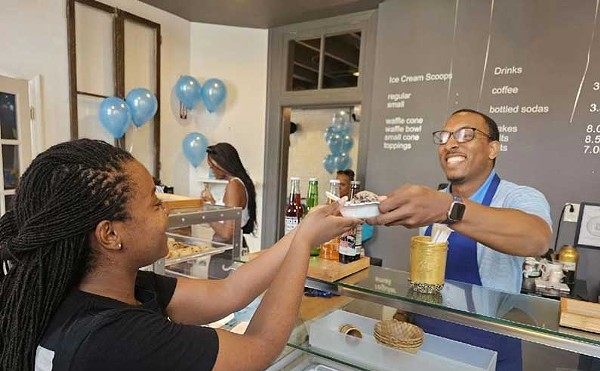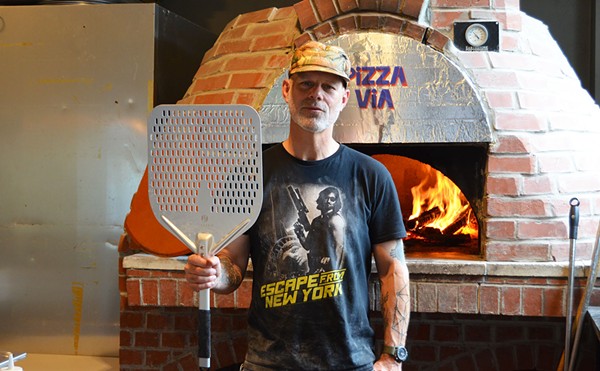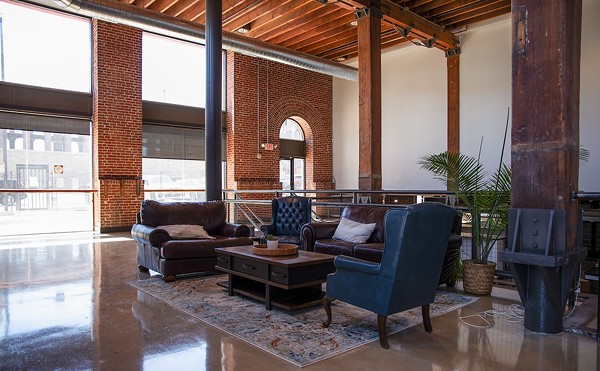Massa's is a holdover from an era before celebrity chefs, nouvelle cuisine or the Food Network, before supermarket salad bars boasted avocado and radicchio, before you could buy sushi at a major-league baseball game or focaccia in an airport terminal, before us unedumicated Midwestern mouth-breathers knew from pesto, lattes, Gorgonzola, curry, balsamic vinegar, aioli, tilapia, tiramisu, crème brûlée or shiraz. Before food became globalized and fetishized.
In other words, during fine dining's Dark Ages.
Which is not to say Massa's excludes the au courant: Pesto, tilapia, tiramisu and shiraz all appear on the menu. Then again, so do deep-fried chicken strips with honey-mustard sauce, mini-pizzas and burgers, toasted ravioli and shrimp scampi. Perhaps Massa's is so popular because it stretches itself in every culinary direction -- bar food, blue-collar Italian staples, hometown favorites, cholesterol- and carb-conscious fare (marked with little red hearts and blue shields, respectively), whatever's gastronomically trendy -- to please all palates. But sadly, this kitchen-of-all-trades proves master of none: The back of the house operates with a total lack of inspiration, as verve-free and inauthentic as you might fear upon encountering a menu that divvies up entries according to "red sauce" and "white sauce."
You've probably seen Massa's' dinner salad before -- when you had lunch with Grandma in the nursing-home cafeteria, or at your cousin's wedding reception at the Ramada Inn. It comes on a glass plate, and it has obviously been crafted of pre-chopped iceberg, pre-shaved carrot splinters, a few thin slices of pre-whatevered red cabbage and a goopy white "creamy Italian" dressing. Among perfunctory salads, this one is an institution, largely because it's often served in institutions. Massa's actually manages to mal-tweak this salad even more by depositing a single, whole, stem-on pepperoncini or cherry pepper (there was one and then the other on two separate visits) along the edge of the plate, an inexplicable, bizarre, groundless choice that belies the rest of the salad's texture (why is everything else sliced but not this?) and content (cukes, tomatoes or plenty of other veggies should join in before anything from the chile family does).
Steamed mussels, an appetizer, came to the table rubbery, lukewarm and khaki-hued; what they did not come with were seafood forks or a bowl for discarded shells. Toasted artichoke hearts were actually fried in a tempura batter, which soaked up so much oil that the grease was more tangible than any artichoke flavor. No fun at all for the artichoke aficionado, they're just another finger food to dip -- into a "white" sauce, this one reminiscent of tartar, but with cracked black pepper substituting for minced pickles.
A main course of lobster ravioli clung for dear life to a half-dozen cubes of perky red tomato, which offered some relief from a seafood stuffing as mealy as the mussels and a cream sauce ("white" again) as blunt and oppressive as the dressing on the house salad. For chicken pesto pasta, the kitchen went berserk with the pesto, which can be overbearing if it coats too heavily as it did these tough, chewy, castoff pieces of poultry. Chicken bianco, a breaded breast billed "a Massa's specialty since 1976," looked like something lifted off the label of a Campbell's soup can. Strange how a "white wine and fresh mushroom sauce" can be so easily confused with brown sludge, and sad how a single vibrant stalk of kelly-green broccoli served on the side can look so scrumptious and crunchy yet taste overboiled, limp and wimpy.
I was intrigued by the "Combination," described under the "Pastas with Red Sauce" heading as "a combination of ravioli, spaghetti, and penne, baked with meat sauce and cheese." How weird does that sound? Like the mussels, it managed to come to the table both overdone and underheated. It was exactly how I pictured it: a starch-insane, hodgepodge casserole treated with a gravy too plain to merit the term "Bolognese" -- like the 3 a.m. pantry-raiding handiwork of a pasta-obsessed packrat.
Desserts were no better. The cannoli's shell was stale. The tiramisu, a drunkard's dream, must have fallen into a barrel of Marsala on its way to the plate. I liked the spumoni, which was really just a bowl of chocolate ice cream with a whipped-cream doodad on top. The wine list contains limited descriptions (the vintage, and sometimes the nation of origin), lacks vision and seems to have been curated by committee -- or at least by someone whose passion isn't wine. Bottles under $35 are plentiful but California-heavy and humdrum: Kendall Jackson, Estancia, Callaway, Mondavi. Australian humdrum is available via Rosemount, Greg Norman, etc. To drink something interesting, you'll pay a premium: $49 for a 1997 Franus zinfandel (a great year for California zin) or $80 for a bottle of 1987 Trefethen cabernet sauvignon.
Even if you're willing to shell out for it, an $80 bottle of wine isn't at home in a place like Massa's. There's nothing on the menu that would likely live up to a seventeen-year-old cab. Nor does the ambiance, the décor -- bland beige, mauve and soft green tones that all but swallow up the smattering of uninteresting art on the walls -- or the service. The waitstaff can be pleasant, but it's largely all business and unsolicitous. When our party requested individual plates for our shared appetizers, a busboy dropped off a stack of saucers -- which would be fine, if this were the Old Country Buffet. There was no clearing between courses -- no appreciation, in other words, for what translates the presence of food into a meal, and a great meal into a great evening. Even that chocolate ice cream (er, spumoni) was undermined by the fact that I was left to enjoy it while staring at the remains of my mostly untouched broccoli and a pesto-encrusted dinner fork.
The Kirkwood location is but one entry in a Massa's trifecta -- there's a location in Ballwin and the flagship in Bridgeton. Considering the Kirkwood crowd, I'm guessing they pack 'em in out west and up north as well. But I'm still wondering what their secret is.





